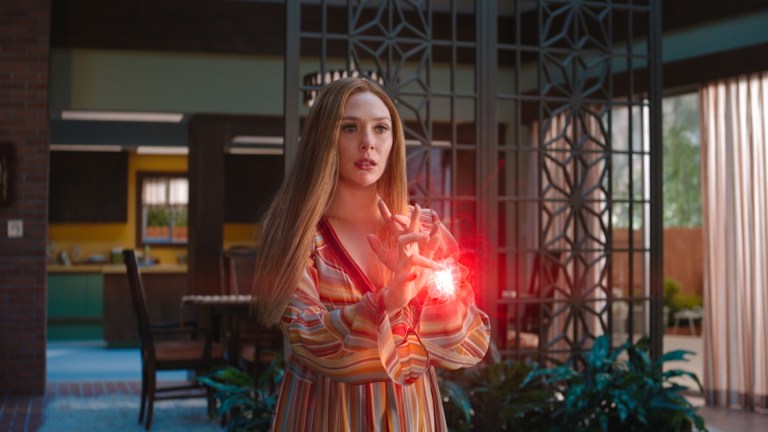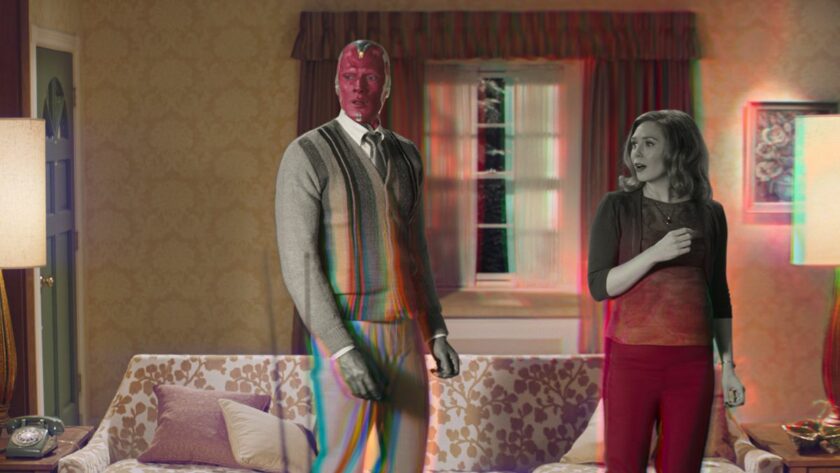Isabel Milford offers her thoughts on the first four episodes of Wandavision, the show beginning Phase Four of the Marvel Cinematic Universe.
Brand new to your screen, in a 4:3 aspect ratio and coated in low contrast black and white, this highly-stylised remediation of the good old-fashioned American sitcom is… the latest project from the Marvel Cinematic Universe? Surely not. The franchise known for flashy superhero suits, occasional trips to outer space, and brutal destruction of skyscrapers? But this is WandaVision alright, and it might just be Marvel’s most interesting on-screen creation yet. The first four episodes are out now, but a fair bit of MCU knowledge is required to understand the series in full, with hints from the Marvel comics also coming into play.
WandaVision follows Wanda Maximoff, also known as Scarlet Witch (Elizabeth Olsen) and Vision (Paul Bettany) as they appear to settle in to a life of suburban bliss in a small town in New Jersey, but everything is not so idyllic as it first may seem. So far, they’ve appeared in three different decades, so time and reality are not quite right. But the show comes post-‘Snap’ and ‘Blip’, and after Avengers: Endgame, and so an important question looms… How is Vision alive? In Avengers: Infinity War, Wanda suffered immense tragedy and trauma, first causing Vision’s death whilst trying to break the soul stone implanted in his head, and then witnessing the villain Thanos rewind time in front of her to steal it, leaving Vision a lifeless robotic zombie figure. Aside from the protagonists, various minor MCU characters also appear in WandaVision, so far including Dr Darcy Lewis from the Thor films, Agent Jimmy Woo from the Ant Man series, and the now grown-up Monica Rambeau — known here as ‘Geraldine’ — previously seen in Captain Marvel. Additionally, many easter eggs can be found throughout the set and during cutaway sequences. These Easter eggs, as well as the old and new characters, and Wanda’s increasing powers hold clues about how WandaVision is intertwined with the larger MCU, with the biggest theory claiming that it will lead onto the upcoming Doctor Strange in the Multiverse of Madness.

But let’s take a step back from the seemingly endless void of information that constitutes the Marvel Cinematic Universe, and focus on WandaVision as a series. The show begins as a step in a completely new aesthetic direction for Marvel, and this dark-suburban atmosphere is their most interesting and creative stance yet; a breakaway from the usual conventions and sci-fi superhero visuals. The roles Wanda and Vision take up here are reminiscent of Samantha and Darrin of Bewitched or Mork and Mindy in, well, Mork & Mindy. The episodes don’t feel like spoof or parody, but rather a loving homage to past sitcoms, with a sense of irony topping off the wink-wink-nudge-nudge style of humour.
Speaking of humour, Paul Bettany is hilarious. He has seamlessly transitioned from voicing Iron Man’s AI butler J.A.R.V.I.S, to acting as Vision, to bumbling around as a 1960s amateur magician. He becomes the comedic heart of this constructed sitcom world. His spontaneous burst into the song Yakety Yak amongst the dinner party chaos in episode one is a pure delight. Vision is usually a knowledgeable and highly skilled member of The Avengers, and so to see Bettany’s performance here is entirely refreshing. I also, however, cannot ignore the pure fun of Olsen attempting to hide her pregnant figure from ‘Geraldine’ whilst trying to magic away a rogue stork. This comedic moment combines with other animal motifs to create a thread between the episodes that could hold more meaning later on.
But humourous behaviour is not the sum total of WandaVision’s sitcom wonder. Mayes C. Rubeo’s costumes are simply superb, vintage visions of the perfect combination of comic superhero style and 20th-century fashions. The costuming from Rubeo and her team is pure storytelling, having essentially created costumes for a new show every episode. With hair and makeup completing the look, WandaVision becomes pure escapism. Honourable mentions go to Wanda’s wedding dress with the signature 1950s ‘New Look’ shape, Dottie’s bubble-flipped 60s do, Vision’s laidback seventies look, ‘Geraldine’s’ blue ensemble with bright turquoise eyeshadow, and Wanda’s wavy, flowy seventies top that is colour-coordinated with Vision and the set. The set design is just as deliciously satisfying as the costumes, the seventies Brady Bunch-esque home being my personal favourite.

Another way that WandaVision injects itself with that typical sitcom feel is through diegetic ad-breaks. Following the strict social norms of the time, prescribed upon the characters also, these breaks from the storyline hold clues to a reality outside of the strange sitcom world. Episode one contains an almost creepy advert for a ‘Stark’ toaster, that sort of resembles Vision, referencing Iron Man and his father. Episode two shows us a glamorous advert for a ‘Strucker’ watch. The Hydra symbol is clear on the face; this is referencing Wolfgang Von Strucker, a Hydra leader who granted Wanda and her late twin brother their powers through experimentation with the infinity stones. In episode three, we see an advert for ‘Hydra Soak’, packaged in a blue cube resembling the tesseract, and accompanied by the line ‘escape to a world all your own’, which is very telling of the confusing situation at hand. Has Wanda created this new, constructed, fantasy world? Or are the comic characters Agatha Harkness and Mephisto involved, perhaps in the form of nosy neighbors?
Although these moments contribute to the show’s heightened feeling, they pale in comparison to the emotionally gripping slices of eerie terror. In this idyllic setting of picket fences and continual contentment, already creepy as no-one knows why it exists, these moments of panic and shock are simultaneously intriguing and satisfying. They don’t occur often, so when normality is cleverly sliced open in this way you cannot take your eyes off of the screen. From the crying, laughing, hysteria filled choking in episode one, to the red blood of Dottie’s cut palm screaming with life in episode two, to a dazed ‘Geraldine’ splayed out amongst the grass with a spotlight hovering over her as an echoey version of The Monkees’ Daydream Believer lingers. These moments, punctuated with perfect performances and stylised cinematography and sound design, are the height of what is brilliant about WandaVision.

So, when episode four opened in the modern-day, back in widescreen mode, I was slightly disappointed. The sweeping cinematography, car shots, techy environments and location text overlays are back, and we have been dumped into the real world of the MCU. I had been enjoying this stylish break from all the weaponry and heavy military presence usually present in Marvel films, so was flattened upon this return to the typical aesthetic. Inevitably the two worlds had to meet, but I did not appreciate having my eyes opened to this so early on, when this show’s sheer beauty and technique was so new and refreshing. The opening hospital scene is a very emotional take on The Blip’s aftermath. It was good, but I was not fond of this new imaginative atmosphere being dampened by the normalcy we’ve come to expect of techy Marvel sets.
WandaVision is thought-provoking; it plays with your mind and your emotions. It’s technically brilliant, innovative, and it’s imaginatively clever. So, I loved the ending to episode 4, with its aspect ratio changes messing with our perception of reality and the shocking reveal of what appears to be Vision’s true appearance, akin to how he last looked in Avengers: Infinity War. This moment, the closeup on Vision, truly gripped me and pulled me back in after multiple scenes of what felt like any other Marvel film.
Unfortunately, the gorgeous stylisation of the pair’s powers as charming twinkly flourishes are left behind in the mid-century era, and the scientific-military real-world reveal may have been too much too soon. But WandaVision’s trailers promise more decades of eerie fun and many more levels of understanding to be unwrapped, and I can’t wait to see how this wild creation unfolds.




